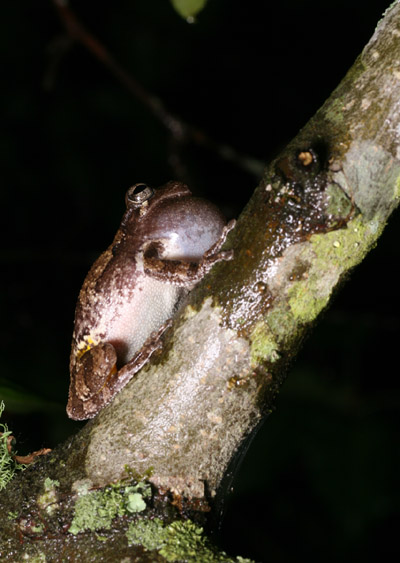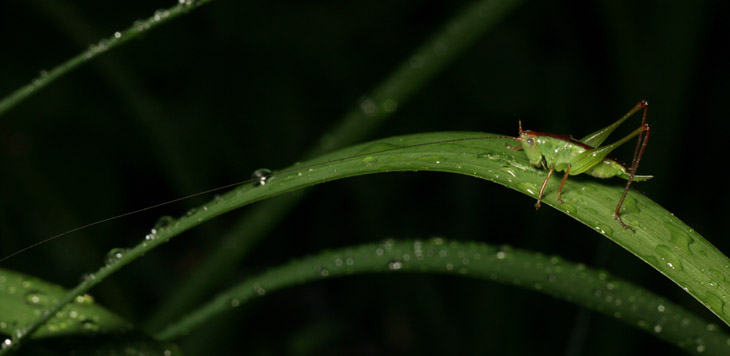Near sunset yesterday the thunderstorms rolled in, with conditions too bright to do any time exposures, and after two hailstorms, the rains came again. It’s only been a week since the last, but with sweltering weather that’s causing the plants to wilt in between, and watching the level in the rain barrel declining drastically, it’s something I pay attention to. However, the day after the last we’d installed a second rain barrel, and they’re both brimming now, so it’s good.
The Girlfriend’s Younger Sprog pointed out the visible structure of one of the hailstones we picked up, and I saved it in the freezer for a quick photo illustration, done today when the temperature had returned to “steamy,” so it was melting rapidly as I got the shots, but it still illustrated the layered nature of the stone, less than a centimeter across at this point.

The first storm deposited ice pellets slightly bigger than candies, but the second one following less than an hour behind dropped misshapen, ugly chunks up to 3 cm across, twisted and gnarled – I’ve never seen anything like it.
After the rain and the sunset, the critters came out to play, notably the treefrogs. The Copes grey treefrogs (Hyla chrysoscelis) were calling enthusiastically, one from the region of the backyard, so of course I had to go out and find it. While it stopped calling as my light approached, it got suckered into a false sense of security when I shut the light off and stood still for a few minutes. I’d suspected it was near the pond, and with a loud creeeeek it revealed itself on the fence immediately adjacent, quite a small specimen.

At higher magnification, the peculiar swollen shape of the toe pads is more visible, but if you look carefully you can see the toes of the farther (right) foreleg are actually propped up on a spiderweb – yes, they’re very long and attenuated. The ubiquitous pine needles can be seen adhering to the wet fence slat behind it, to give an idea of scale – I’d estimate this one to be no more than 4 cm, not much bigger than the gnarly hail.
 More calls were coming from the cattail-bearing ditch alongside the main road nearby, so I naturally checked that out too. There were several in the low branches of a tree right above the ditch, calling exuberantly, though they typically halted as the light struck them, so getting an image of one in mid-croak, as this one is, took a few attempts. It would have been an amusing spectacle, as well: the ground sloped sharply directly under the tree, and as I was trying for a good vantage I would attempt to be higher up the slope, which was extremely slippery. With care and patience I would achieve a stable position, but then I’d raise the camera and shift my balance, often as not abruptly losing my footing and doing that sudden eruption of flailing arms at odd angles in an attempt to maintain balance. This was punctuated by both a headlamp and a focusing light on the camera, which would also thrash around in all directions. It must have looked great…
More calls were coming from the cattail-bearing ditch alongside the main road nearby, so I naturally checked that out too. There were several in the low branches of a tree right above the ditch, calling exuberantly, though they typically halted as the light struck them, so getting an image of one in mid-croak, as this one is, took a few attempts. It would have been an amusing spectacle, as well: the ground sloped sharply directly under the tree, and as I was trying for a good vantage I would attempt to be higher up the slope, which was extremely slippery. With care and patience I would achieve a stable position, but then I’d raise the camera and shift my balance, often as not abruptly losing my footing and doing that sudden eruption of flailing arms at odd angles in an attempt to maintain balance. This was punctuated by both a headlamp and a focusing light on the camera, which would also thrash around in all directions. It must have looked great…
I had thoughtfully brought along the voice recorder, so I did a few recordings of the frogs sounding off, one of which was in a branch directly overhead, maybe a meter from the recorder. To get a real feel for it, boost your volume up a bit – the call should almost make you wince.
My favorite photo remains this one, however, taken before another graceless skid down the incline.

There were other critters out taking advantage of the humidity as well – the cattails in the ditch sported a variety of insects, including more mantids and this lesser meadow katydid nymph (genus Conocephalus.) It’s easy to mistake it for a grasshopper – I did, anyway – mostly because they’re closely related. You’ll see more of this species – kinda – shortly.

I took another quick trip across to the local pond, spotting several bullfrogs and an untold number of long-jawed orb weavers, spurred into action by the recognition that the rain would produce more flying insect activity as well. It’s also been a very good season for mantids, which can be found everywhere. This minuscule specimen was parading proudly on another patch of cattails, different from the previous.

 Observing the mist rising from the waters of the pond by the light of a half-moon, I went back and got the tripod to do a few time exposures. While I didn’t get anything exciting, and the low-lying steam can only faintly be made out, I did at least capture a firefly in the frame, the streak faintly visible against the sky – one of these days I’ll have to go to a location where they’re very active and do some more long-exposure shots. This one also captured a bit of depth among the background trees – other frames rendered them more of a single-plane silhouette. The green glow from the right is evidence of a mercury street lamp, the kind that are blue to our eyes. Even when I can selectively block the bulb itself from appearing in the frame, it’s hard to eradicate the light spilling from them. I’ll just have to locate a pond without any nearby lights, which could be a challenge.
Observing the mist rising from the waters of the pond by the light of a half-moon, I went back and got the tripod to do a few time exposures. While I didn’t get anything exciting, and the low-lying steam can only faintly be made out, I did at least capture a firefly in the frame, the streak faintly visible against the sky – one of these days I’ll have to go to a location where they’re very active and do some more long-exposure shots. This one also captured a bit of depth among the background trees – other frames rendered them more of a single-plane silhouette. The green glow from the right is evidence of a mercury street lamp, the kind that are blue to our eyes. Even when I can selectively block the bulb itself from appearing in the frame, it’s hard to eradicate the light spilling from them. I’ll just have to locate a pond without any nearby lights, which could be a challenge.
By the way, see the faint smudge just off the leaves in the top right corner? That’s one of the aforementioned spiders, not quite holding still for the five-minute exposure. I actually did another shot of one above the moon (creative positioning,) using the light from the headlamp to illuminate it for a short exposure against the glare of the moon, but it didn’t come out quite the way I wanted, so that remains a project for a little later on.
 At midday today the evidence of the rains still remained in places (I mean, aside from the debris knocked down by the wind and hail,) despite the temperature. Which is good – it will all vanish soon enough. In a little bit I’ll be back with more photos from today, but I’ll inform you ahead of time – all insects, and some may be considered pretty disgusting. I probably don’t have to worry about that anymore, since anyone likely to be affected by that learned their lesson long ago and hasn’t returned.
At midday today the evidence of the rains still remained in places (I mean, aside from the debris knocked down by the wind and hail,) despite the temperature. Which is good – it will all vanish soon enough. In a little bit I’ll be back with more photos from today, but I’ll inform you ahead of time – all insects, and some may be considered pretty disgusting. I probably don’t have to worry about that anymore, since anyone likely to be affected by that learned their lesson long ago and hasn’t returned.




















































